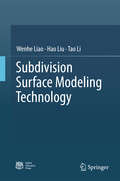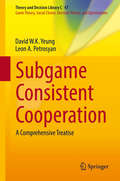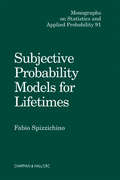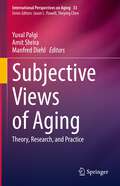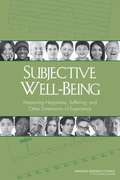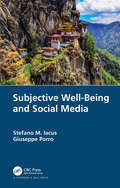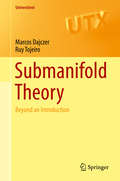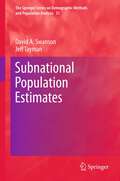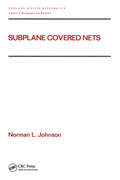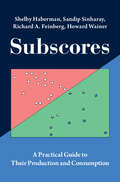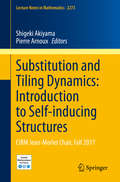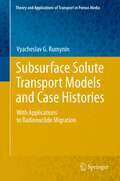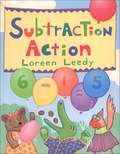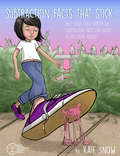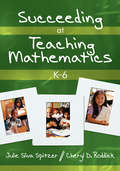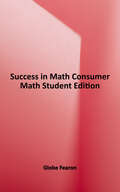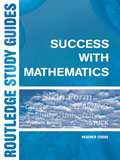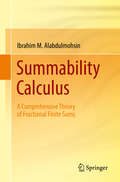- Table View
- List View
Subdivision Surface Modeling Technology
by Tao Li Hao Liu Wenhe LiaoThis book offers a comprehensive introduction to Subdivision Surface Modeling Technology focusing not only on fundamental theories but also on practical applications. It furthers readers’ understanding of the contacts between spline surfaces and subdivision surfaces, enabling them to master the Subdivision Surface Modeling Technology for analyzing subdivision surfaces. Subdivision surface modeling is a popular technology in the field of computer aided design (CAD) and computer graphics (CG) thanks to its ability to model meshes of any topology. The book also discusses some typical Subdivision Surface Modeling Technologies, such as interpolation, fitting, fairing, intersection, as well as trimming and interactive editing. It is a valuable tool, enabling readers to grasp the main technologies of subdivision surface modeling and use them in software development, which in turn leads to a better understanding of CAD/CG software operations.
Subgame Consistent Cooperation
by Leon A. Petrosyan David W.K. YeungStrategic behavior in the human and social world has been increasingly recognized in theory and practice. It is well known that non-cooperative behavior could lead to suboptimal or even highly undesirable outcomes. Cooperation suggests the possibility of obtaining socially optimal solutions and the calls for cooperation are prevalent in real-life problems. Dynamic cooperation cannot be sustainable if there is no guarantee that the agreed upon optimality principle at the beginning is maintained throughout the cooperation duration. It is due to the lack of this kind of guarantees that cooperative schemes fail to last till its end or even fail to get started. The property of subgame consistency in cooperative dynamic games and the corresponding solution mechanism resolve this "classic" problem in game theory. This book is a comprehensive treatise on subgame consistent dynamic cooperation covering the up-to-date state of the art analyses in this important topic. It sets out to provide the theory, solution techniques and applications of subgame consistent cooperation in a wide spectrum of paradigms for analysis which includes cooperative dynamic game models with stochastic state dynamics, with uncertain future payoffs, with asynchronous players' horizons, with random cooperation duration, with control spaces switching and with transferable and nontransferable payoffs. The book would be a significant research reference text for researchers in game theory, economists, applied mathematicians, policy-makers, corporate decision-makers, and graduate students in applied mathematics, game theory, decision sciences, economics and management sciences.
Subgame Consistent Economic Optimization: An Advanced Cooperative Dynamic Game Analysis (Static & Dynamic Game Theory: Foundations & Applications)
by Leon A. Petrosyan David W.K. YeungVarious imperfections in existing market systems prevent the free market from serving as a truly efficient allocation mechanism, but optimization of economic activities provides an effective remedial measure. Cooperative optimization claims that socially optimal and individually rational solutions to decision problems involving strategic action over time exist. To ensure that cooperation will last throughout the agreement period, however, the stringent condition of subgame consistency is required. This textbook presents a study of subgame consistent economic optimization, developing game-theoretic optimization techniques to establish the foundation for an effective policy menu to tackle the suboptimal behavior that the conventional market mechanism fails to resolve.
Subjective Probability Models for Lifetimes (Chapman & Hall/CRC Monographs on Statistics and Applied Probability)
by Fabio SpizzichinoBayesian methods in reliability cannot be fully utilized and understood without full comprehension of the essential differences that exist between frequentist probability and subjective probability. Switching from the frequentist to the subjective approach requires that some fundamental concepts be rethought and suitably redefined. Subjecti
Subjective Views of Aging: Theory, Research, and Practice (International Perspectives on Aging #33)
by Manfred Diehl Yuval Palgi Amit ShriraThis book focuses on the concept of subjective views of aging. This concept refers to the way individuals conceptualize and perceive the aging process. Social and cultural perceptions regarding older adults are incorporated and internalized into views people hold regarding their own aging process. The book contains three parts which present theoretical, empirical, and translational perspectives about subjective views of aging. The theoretical section expands the framework of subjective views of aging with the inclusion of additional concepts, and further integrates these concepts by accounting for their synergistic effects. The empirical section presents recent developments in the field starting at the intra-individual level as assessed by ecological momentary assessments, going through the level of interpersonal relationships, and concluding at the social and cultural levels. Finally, the translational section presents recent endeavours to develop interventions aimed at advancing favourable views of aging. This cutting-edge edited book includes chapters written by internationally renowned scholars in the field and serves as an up-to-date resource for scholars in the field as well as a textbook for students in courses like social gerontology, lifespan psychology, and life course sociology.
Subjective Well-Being
by National Research Council Committee on National Statistics Panel on Measuring Subjective Well-Being in a Policy-Relevant Framework Division on Behavioral and Social Sciences and Education Christopher Mackie Arthur A. StoneSubjective well-being refers to how people experience and evaluate their lives and specific domains and activities in their lives. This information has already proven valuable to researchers, who have produced insights about the emotional states and experiences of people belonging to different groups, engaged in different activities, at different points in the life course, and involved in different family and community structures. Research has also revealed relationships between people's self-reported, subjectively assessed states and their behavior and decisions. Research on subjective well-being has been ongoing for decades, providing new information about the human condition. During the past decade, interest in the topic among policy makers, national statistical offices, academic researchers, the media, and the public has increased markedly because of its potential for shedding light on the economic, social, and health conditions of populations and for informing policy decisions across these domains. Subjective Well-Being: Measuring Happiness, Suffering, and Other Dimensions of Experience explores the use of this measure in population surveys. This report reviews the current state of research and evaluates methods for the measurement. In this report, a range of potential experienced well-being data applications are cited, from cost-benefit studies of health care delivery to commuting and transportation planning, environmental valuation, and outdoor recreation resource monitoring, and even to assessment of end-of-life treatment options. Subjective Well-Being finds that, whether used to assess the consequence of people's situations and policies that might affect them or to explore determinants of outcomes, contextual and covariate data are needed alongside the subjective well-being measures. This report offers guidance about adopting subjective well-being measures in official government surveys to inform social and economic policies and considers whether research has advanced to a point which warrants the federal government collecting data that allow aspects of the population's subjective well-being to be tracked and associated with changing conditions.
Subjective Well-Being and Social Media
by Stefano M. Iacus Giuseppe PorroSubjective Well-Being and Social Media shows how, by exploiting the unprecedented amount of information provided by the social networking sites, it is possible to build new composite indicators of subjective well-being. These new social media indicators are complementary to official statistics and surveys, whose data are collected at very low temporary and geographical resolution. The book also explains in full details how to solve the problem of selection bias coming from social media data. Mixing textual analysis, machine learning and time series analysis, the book also shows how to extract both the structural and the temporary components of subjective well-being. Cross-country analysis confirms that well-being is a complex phenomenon that is governed by macroeconomic and health factors, ageing, temporary shocks and cultural and psychological aspects. As an example, the last part of the book focuses on the impact of the prolonged stress due to the COVID-19 pandemic on subjective well-being in both Japan and Italy. Through a data science approach, the results show that a consistent and persistent drop occurred throughout 2020 in the overall level of well-being in both countries. The methodology presented in this book: enables social scientists and policy makers to know what people think about the quality of their own life, minimizing the bias induced by the interaction between the researcher and the observed individuals; being language-free, it allows for comparing the well-being perceived in different linguistic and socio-cultural contexts, disentangling differences due to objective events and life conditions from dissimilarities related to social norms or language specificities; provides a solution to the problem of selection bias in social media data through a systematic approach based on time-space small area estimation models. The book comes also with replication R scripts and data. Stefano M. Iacus is full professor of Statistics at the University of Milan, on leave at the Joint Research Centre of the European Commission. Former R-core member (1999-2017) and R Foundation Member. Giuseppe Porro is full professor of Economic Policy at the University of Insubria. An earlier version of this project was awarded the Italian Institute of Statistics-Google prize for "official statistics and big data".
Submanifold Theory: Beyond an Introduction (Universitext)
by Marcos Dajczer Ruy TojeiroThis book provides a comprehensive introduction to Submanifold theory, focusing on general properties of isometric and conformal immersions of Riemannian manifolds into space forms. One main theme is the isometric and conformal deformation problem for submanifolds of arbitrary dimension and codimension. Several relevant classes of submanifolds are also discussed, including constant curvature submanifolds, submanifolds of nonpositive extrinsic curvature, conformally flat submanifolds and real Kaehler submanifolds. This is the first textbook to treat a substantial proportion of the material presented here. The first chapters are suitable for an introductory course on Submanifold theory for students with a basic background on Riemannian geometry. The remaining chapters could be used in a more advanced course by students aiming at initiating research on the subject, and are also intended to serve as a reference for specialists in the field.
Subnational Population Estimates
by David A. Swanson Jeff TaymanProviding a unified and comprehensive treatment of the theory and techniques of sub-national population estimation, this much-needed publication does more than collate disparate source material. It examines hitherto unexplored methodological links between differing types of estimation from both the demographic and sample-survey traditions and is a self-contained primer that combines academic rigor with a wealth of real-world examples that are useful models for demographers. Between censuses, which are expensive, administratively complex, and thus infrequent, demographers and government officials must estimate population using either demographic modeling techniques or statistical surveys that sample a fraction of residents. These estimates play a central role in vital decisions that range from funding allocations and rate-setting to education, health and housing provision. They also provide important data to companies undertaking market research. However, mastering small-area and sub-national population estimation is complicated by scattered, incomplete and outdated academic sources--an issue this volume tackles head-on. Rapidly increasing population mobility is making inter-census estimation ever more important to strategic planners. This book will make the theory and techniques involved more accessible to anyone with an interest in developing or using population estimates.
Subplane Covered Nets (Chapman & Hall/CRC Pure and Applied Mathematics)
by Norman L. JohnsonThis work confronts the question of geometric processes of derivation, specifically the derivation of affine planes - keying in on construction techniques and types of transformations in which lines of a newly-created plane can be understood as subplanes of the original plane. The book provides a theory of subplane covered nets without restriction
Subscores: A Practical Guide to Their Production and Consumption
by Shelby Haberman Sandip Sinharay Richard A. Feinberg Howard WainerThis authoritative guide directs consumers and users of test scores on when and how to provide subscores and how to make informed decisions based on them. The book is designed to be accessible to practitioners and score users with varying levels of technical expertise, from executives of testing organizations and students who take tests to graduate students in educational measurement, psychometricians, and test developers. The theoretical background required to evaluate subscores and improve them are provided alongside examples of tests with subscores to illustrate their use and misuse. The first chapter covers the history of tests, subtests, scores, and subscores. Later chapters go into subscore reporting, evaluating and improving the quality of subscores, and alternatives to subscores when they are not appropriate. This thorough introduction to the existing research and best practices will be useful to graduate students, researchers, and practitioners.
Substitution and Tiling Dynamics: CIRM Jean-Morlet Chair, Fall 2017 (Lecture Notes in Mathematics #2273)
by Shigeki Akiyama Pierre ArnouxThis book presents a panorama of recent developments in the theory of tilings and related dynamical systems. It contains an expanded version of courses given in 2017 at the research school associated with the Jean-Morlet chair program.Tilings have been designed, used and studied for centuries in various contexts. This field grew significantly after the discovery of aperiodic self-similar tilings in the 60s, linked to the proof of the undecidability of the Domino problem, and was driven futher by Dan Shechtman's discovery of quasicrystals in 1984. Tiling problems establish a bridge between the mutually influential fields of geometry, dynamical systems, aperiodic order, computer science, number theory, algebra and logic. The main properties of tiling dynamical systems are covered, with expositions on recent results in self-similarity (and its generalizations, fusions rules and S-adic systems), algebraic developments connected to physics, games and undecidability questions, and the spectrum of substitution tilings.
Substructuring Method for Civil Structural Health Monitoring (Engineering Applications of Computational Methods #15)
by Yong Xia Shun Weng Hongping ZhuThis book investigates the substructuring technology in structural health monitoring (SHM) to improve the accuracy and efficiency of the present SHM methods. SHM has been developed for monitoring, evaluation, and maintenance of civil structures. As the civil structures are usually large scale and a large number of sensors are deployed on a structure, accurate evaluation and maintenance of civil structures are always time-consuming. The book establishes a fundamental framework of substructuring method for the fast analysis of finite element (FE) model and monitoring data. Several practical civil structures are used for illustration. The book is intended for undergraduate and graduate students who are interested in SHM technology, researchers investigating the accurate, efficient, and effective methods in SHM field, and engineers working on evaluation and maintenance of civil structures or other structural dynamics applications.
Subsurface Environmental Modelling Between Science and Policy (Advances in Geophysical and Environmental Mechanics and Mathematics)
by Dirk Scheer Holger Class Bernd FlemischThis book provides a broad overview of essential features of subsurface environmental modelling at the science-policy interface, offering insights into the potential challenges in the field of subsurface flow and transport, as well as the corresponding computational modelling and its impact on the area of policy- and decision-making. The book is divided into two parts: Part I presents models, methods and software at the science-policy interface. Building on this, Part II illustrates the specifications using detailed case studies of subsurface environmental modelling. It also includes a systematic research overview and discusses the anthropogenic use of the subsurface, with a particular focus on energy-related technologies, such as carbon sequestration, geothermal technologies, fluid and energy storage, nuclear waste disposal, and unconventional oil and gas recovery.
Subsurface Solute Transport Models and Case Histories
by Vyacheslav G. RumyninThe book addresses the development of the basic knowledge of the subsurface solute transfer with a particular emphasis on field data collection and analysis coupled with modeling (analytical and numerical) tool application. The relevant theoretical developments are concerned mainly with the formulation and solution of deterministic mass-transport equations for a wide range of engineering issues in groundwater quality assessment and forecasting. The book gives many computational examples and case studies drawn from the conducted field investigations. The analyzed problems are as follows: investigation and prediction of groundwater contamination by industrial contaminants and solutions (radionuclides, chloride and nitrate brine) with special focus on the effect of (a) aquifer heterogeneity, anisotropy, and dual porosity, (b) density contrast existing between industrial waste and groundwater, or in density-stratified artesian and coastal groundwater systems; (c) physicochemical interactions that play a major role in retarding (e.g. adsorption) or enhancing (e.g. interactions between dissolved species and mobile colloids) contaminant transport;prediction of the effects of pumping on groundwater quality at wellfields;groundwater dating using stable and radioactive isotopes for prediction and assessment of contamination potential;field and laboratory tests' design and analysis, and monitoring data interpretation;partitioning of surface and subsurface flows using isotope techniques.One of the most essential topics addressed in the book is the migration and fate of radionuclides. Model development is motivated by field data analysis from a number of radioactively contaminated sites in the Russian Federation: near-surface radioactive waste disposal sites and deep-well radioactive waste injection sites. They play a unique role in the advancement of knowledge of the subsurface behavior and fate of many hazardous radionuclides and can be considered as field-scale laboratories. Thus, the book, along with theoretical findings, contains field information, which will facilitate the understanding of subsurface solute transport and the development of a methodology for practical applications to groundwater hydrology.
Subtraction Action
by Loreen LeedyIntroduces subtraction through the activities of animal students.
Subtraction Facts that Stick: Help Your Child Master the Subtraction Facts for Good in Just Eight Weeks
by Corrin Brewer Debra Pearson Kate SnowThe fun, engaging program that will help your child master the subtraction facts once and for all—without spending hours and hours drilling flash cards! Subtraction Facts That Stick will guide you, step-by- step, as you teach your child to understand and memorize the subtraction facts, from 1 - 1 through 9 - 9. Hands-on activities, fun games your child will love, and simple practice pages help young students remember the subtraction facts for good. In 15 minutes per day (perfect for after school, or as a supplement to a homeschool math curriculum) your child will master the subtraction facts, gain a greater understanding of how math works, and develop greater confidence, in just six weeks! Mastery of the math facts is the foundation for all future math learning. Lay that foundation now, and make it solid, with Subtraction Facts That Stick!
Succeeding at Teaching Mathematics, K-6
by Dr Cheryl D. Roddick Julie A. Sliva SpitzerThis invaluable resource helps beginning educators focus on the big ideas in teaching mathematics and promote student engagement.
Succeeding at Teaching Secondary Mathematics: Your First Year
by Dr Cheryl D. Roddick Julie A. Sliva SpitzerThis practical resource helps beginning secondary mathematics teachers design a curriculum that is meaningful, differentiate instruction, engage students, meet standards, assess student understanding, and more.
Success in Math: Consumer Math (Success in Math Series)
by Globe FearonThis book helps students with varying learning styles master basic math concepts and prepares them for success on math competency tests. Student Texts This five-book softcover series breaks down core math concepts into short, manageable lessons that assume little background knowledge and are introduced in real-life contexts. In addition, chapter opener vocabulary lists and a glossary prove valuable for English language learners with below- or at-level math skills. Teacher's resources include answer Keys, as well as error analysis notes, alternative strategies for varied learning styles, problem-solving strategies, ESL notes, cooperative learning strategies, and reproducible masters are provided. - Helps students with varying learning styles master the basic math concepts they need to meet rigorous high school math and testing requirements. - Introduces students to the working world by presenting real-world examples and problems. - Supports independent learning with instruction, exercises, and partial Answer Keys.
Success with Mathematics
by Heather CookeMany students find the leap between school and university level mathematics to be significantly greater than they expected. Success with Mathematics has been devised and written especially in order to help students bridge that gap. It offers clear, practical guidance from experienced teachers of mathematics in higher education on such key issues as: * getting started* ways of studying* assessment* mathematical communication* learning by doing* using ICT* using calculators* what next.After reading this book, students will find themselves better prepared for the change in pace, rigour and abstraction they encounter in degree level mathematics. They will also find themselves able to broaden their learning strategies and improve their self-directed study skills. This book is essential reading for anyone following, or about to undertake, a degree in mathematics, or other degree courses with mathematical content.
Suficientes zanahorias: Just Enough Carrots (Spanish Edition) (MathStart 1)
by Stuart J. Murphy“Kids, young and old, fall in love with math when they see how real-life and effortless it becomes thanks to these books.” —Kimberly D. Mueller, Ed.D., First Grade Teacher, Ashbrook School, Lumberton NJThis high-quality Spanish-language book can be enjoyed by fluent Spanish speakers as well as those learning the language, whether at home or in a classroom.The MathStart series has sold over 1.5 million copies and combines math with fun stories that have real-life applications. In Suficientes zanahorias, a Level One MathStart, children learn to formulate addition and subtraction equations and identify “more,” “fewer,” and “the same.”Cuando Conejo va de compras al supermercado con su mamá, comparar cantidades le resulta fácil. Sabe lo que deben comprar: á más zanahorias y menos lombrices!Math skills are life skills, and the MathStart series supports success!This award-winning series by Stuart J. Murphy teaches math through stories and visual models63 books divided into three levels with 21 books in eachFun activities kids will love are included to help parents and teachers emphasize the lessonsEngaging and relatable stories, with each story revolving around practical applications of the math concept presentedLively art from top-notch illustratorsCharts and other visual representations help children understand how the math works and promote deeper comprehensionMathStart's unique combination of stories, illustrations, and visual models helps teachers and parents in the teaching of math and provides all children with the opportunity to succeed.The math concepts taught in MathStart books conform to state and national standards. Level 1 is Pre-K–Kindergarten; Level 2 is Grades 1–3; Level 3 is Grades 2–4. The series follows math topics across grades so there is a foundational path to learning that runs through the levels.Help kids with their math skills plus their reading skills with the engaging and fun MathStart series!
Sum of Us: A History of the UK in Data
by Georgina SturgeWhat has data ever done for us?Georgina Sturge, House of Commons Library statistician and author of the critically acclaimed Bad Data, explores the rich history of the times the UK has counted itself - from the revolutionary first census of 1801 to modern worries over technological surveillance.Condensing a whole society into numbers brought hidden problems to light: mapping cholera deaths in Soho led researchers to a single deadly water pump; Florence Nightingale stunned the Victorian establishment with her diagrams showing disease was the soldier's hidden enemy; and the discovery that industries like firework-making were almost entirely staffed by women helped improve workers' rights.The census also reveals the people left out of the nation's story. Records reveal the remarkable presence of escaped American slaves living in nineteenth century Leeds, and that by 1901 there were 600 professional Italian cooks in the UK. More recent data has acknowledged religion, ethnicity, and LGBT identity for the first time. Sturge also tracks those who have resisted the state's attempts at tabulation - people burning survey forms, stripping naked in protest and, in the case of 500 Suffragettes, avoiding the 1911 census by skating all night round Aldwych roller rink.Full of fascinating social detail, Sum of Us draws out the human stories captured in the vast tangle of data the UK has collected over two centuries. It provides a vital snapshot not of who we imagine ourselves to be - but who we really are.
Sum of Us: A History of the UK in Data
by Georgina SturgeWhat has data ever done for us?Georgina Sturge, House of Commons Library statistician and author of the critically acclaimed Bad Data, explores the rich history of the times the UK has counted itself - from the revolutionary first census of 1801 to modern worries over technological surveillance.Condensing a whole society into numbers brought hidden problems to light: mapping cholera deaths in Soho led researchers to a single deadly water pump; Florence Nightingale stunned the Victorian establishment with her diagrams showing disease was the soldier's hidden enemy; and the discovery that industries like firework-making were almost entirely staffed by women helped improve workers' rights.The census also reveals the people left out of the nation's story. Records reveal the remarkable presence of escaped American slaves living in nineteenth century Leeds, and that by 1901 there were 600 professional Italian cooks in the UK. More recent data has acknowledged religion, ethnicity, and LGBT identity for the first time. Sturge also tracks those who have resisted the state's attempts at tabulation - people burning survey forms, stripping naked in protest and, in the case of 500 Suffragettes, avoiding the 1911 census by skating all night round Aldwych roller rink.Full of fascinating social detail, Sum of Us draws out the human stories captured in the vast tangle of data the UK has collected over two centuries. It provides a vital snapshot not of who we imagine ourselves to be - but who we really are.
Summability Calculus: A Comprehensive Theory Of Fractional Finite Sums
by Ibrahim M. AlabdulmohsinThis book develops the foundations of "summability calculus", which is a comprehensive theory of fractional finite sums. It fills an important gap in the literature by unifying and extending disparate historical results. It also presents new material that has not been published before. Importantly, it shows how the study of fractional finite sums benefits from and contributes to many areas of mathematics, such as divergent series, numerical integration, approximation theory, asymptotic methods, special functions, series acceleration, Fourier analysis, the calculus of finite differences, and information theory. As such, it appeals to a wide audience of mathematicians whose interests include the study of special functions, summability theory, analytic number theory, series and sequences, approximation theory, asymptotic expansions, or numerical methods. Richly illustrated, it features chapter summaries, and includes numerous examples and exercises. The content is mostly developed from scratch using only undergraduate mathematics, such as calculus and linear algebra.
